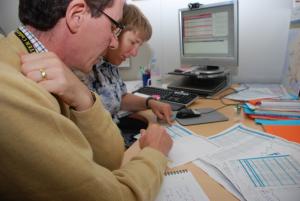Planning the master plan
"Building an airplane is not quite as easy as baking biscuits," the Head of Airbus Industries, Thomas Enders, jovially replied to journalists on the occasion of his company celebrating the delivery of an A380 to Quantas in October this year.
Well, ITER is not designed to fly. But building the 30 buildings needed for the ITER plant, manufacturing and assembling the more than 30,000 components and about 10 million bits and pieces that will have to fit together to form the ITER machine and to make sure that they arrive in Cadarache on time and in good shape is no biscuit business either.
There is no user manual for the biggest experimental tokamak ever built and with its parts being manufactured in various regions across the world. ITER's central component, the vacuum vessel, for example, will be built partly by Europe and partly by Korea. From Korea, the steel structure will be shipped across the oceans to the port of Fos-sur-Mer in southern France, and then it will be put on wheels to crawl along the 110 kilometres to Cadarache where, with a precision of 5 mm, it will finally be assembled with other parts delivered from Europe, Russia and India.
To make sure that the housing for the steel vessel, the Tokamak Building, is in place when the parts arrive on site, and that all the pipes, cables, busbars, feeders and power supplies are there ready to be connected, it is essential to have a plan. And it had better be a good plan if ITER is to produce First Plasma in 2018.
Currently, about 30 planners within the ITER Organization and the seven Domestic Agencies are elaborating a master plan: the Integrated Project Schedule (IPS). The IPS, a complex network of logically linked tasks, is the roadmap to ITER. Colour-coded bars indicate the timelines allocated to the various parts, giving an indication on how much time is needed to manufacture, deliver and finally install them in the machine. "Our work is based on assumptions," explains Debbie Cox, in charge of transforming assumptions into a master plan for the electron cyclotron and the ion cyclotron heating systems. "Our job has a lot to do with communications," the planner from Thurso in the far north of Scotland explains. "Being a planner does not require special expertise on how to assemble a tokamak. A planner has to be able to extract the information from the people who will actually do the work and format this in a way that it can be communicated to others."
While Debbie concentrates on heating, her colleague Nancy Bernius from the US deals with the assembly of the basic machine, plant and ancillary systems. Currently, she is focusing on ITER's blanket structures. The design of the vacuum vessel includes 440 blanket modules that will have to be bolted to the inner walls. It is up to Nancy to find out how much time will be needed to mount one module and, based on this number, to calculate how long it takes until the whole vessel is covered. "The calculation starts with presuming that we will have two remote handling devices available to move the modules weighing 4.5 tonnes each into the right position. We will then need a working platform for the people fitting in the 5,760 bolts that will hold the modules. We further assume that it will take ten minutes for each bolt. Some jobs can be done simultaneously, others can't. We assume that there will be two 7.5-hour shifts per working day during the Assembly Phase. Then, the blanket modules will have to be delivered to the site three months prior to the start of assembly. There has to be some contingency in the plan," says Nancy. "Mounting the modules should not be the first encounter with the high-tech devices."
At the end of this exercise, Nancy will come up with a number that she will forward to Steve Gilligan, the Planning and Scheduling Section Leader within the ITER Organization. With the input he receives from the planners, Steve then draws the big picture, the Integrated Project Schedule.
Recently, all planners from both the ITER Organization and the Domestic Agencies, along with their counterparts from the technical departments, met in Cadarache for a four-day meeting. "The main goal of this exercise was to improve the communication amongst the teams and thus come to a better understanding of the assumptions made. This we hope will ultimately lead to the development of a more detailed, and thus a more realistic and achievable, project schedule."


